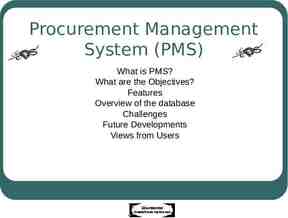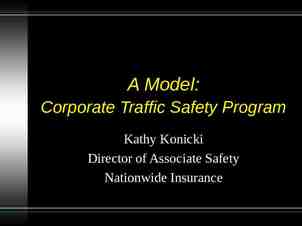Active Shooter – EMS Response September 21, 2016 UNYAN
28 Slides616.19 KB

Active Shooter – EMS Response September 21, 2016 UNYAN Membership Meeting Butch Hoffmann, BA, EMT-P

Today’s Objectives Active Shooter (AS) definition Provide AS behaviors Describe AS situations - unusual Provide case studies - lessons learned Lessons learned from military combat Today’s EMS AS tactics

US DHS – Active Shooter Definition Where individual(s) is ‘actively engaged in killing or attempting to kill in a confined and populated area; in most cases, active shooters use firearms and there is no pattern or method to their selection of victims’. Active Assailant/Hybrid Targeted Violence Incident: One or more suspects, ongoing, random or systematic spree, any weapon with the intent to inflict mass casualties

A Type of Active Shooter Domestic Attacker: Occurring more frequently! American citizen Born in another country, naturalized a U.S. citizen Self-radicalized, no direct contact with terrorist organization ‘Inspired’ by terrorist propaganda i.e. ISIS No combat experience or limited experience with weapons Plan for other attacks

Other Types of AS Attackers Int’l Terrorist Group Extremists Criminal Gangs Insider – mental health, anger or revenge, political / religious beliefs, notoriety

Targets of Opportunity Commerce & Educational environments ( 70%) City streets Military & Governmental properties Private residences House of worship Sporting events Health Care Facilities

Case Study Columbine High School, Colorado – April, 1999 Traditional Police Response Perimeter Secured 45 minutes for SWAT to enter 13 victims shot and killed during SWAT mobilization Shooters committed suicide upon police entry Staged EMS SWAT to clear school before EMS entry One teacher died of hemorrhage. Preventable?

Following Columbine, 1999 Nationwide LE changed their AS SOPs - First few officers form a response team - Don’t wait for command level decisions - Engage the subject(s)

Military Data: 15% of deaths in conventional combat are potentially preventable, COL Ron Bellmany, Vietnam War 1967 -1969 Most common preventable causes of deaths Exsanguination Tension pneumothorax Airway obstruction Tactical Combat Casualty Care (TCCC) developed

Case Study Virginia Tech, Norris Hall – April, 2009 9:40 9:50 Shooting begins ERTs with 2 SWAT Medics enter Norris Hall SWAT medics use TCCC Use multiple chest valves & tourniquets - saved lives 32 killed, 17 wounded, 6 inj’d from falling from windows Rapid police entry forced action of shooter Quick EMS presence saved lives How many AS incidents are occurring annually in the U.S.? 6.4, 16.4, or 20.3

http://www.policeforum.org/assets/docs/Critical Issues Series/the%20police%20response%20to%20active%20shooter%20incidents%202014.pdf

Case Study Cinemark Century 16, Aurora, CO – July, 2012 12:30am begins - Shooter releases tear gas first, then shooting 12 killed, 58 wounded No adequate access route for EMS LE transports victims to local hospital No triage tags, lack of staging No Unified CP during first hour AAR: LE needs medical care training

After Sandy Hook, Conn. – Dec. 2012 FBI, NAEMT, IAFC, ACS & the Military produced Hartford Consensus: a nat’l strategy to enhance the survival rates in mass casualty shootings Past practices of LE, Fire and EMS were not optimally aligned to maximize victim survival Rapid EMS entry integrated with LE would save lives Use military’s TCCC concept; by introducing a civilian version Utilize Rescue Task Force (RTF) concept http://www.policeforum.org/assets/docs/Critical Issues Series/the%20police%20response%20to%20active%20shooter%20incidents%202014.pdf

Hartford Consensus (cont’d) Critical Strategic Responses: ‘THREAT’ Principle T threat suppression H hemorrhage control RE rapid extrication A assessment by EMS providers T transport to definitive care

First Line EMS Providers Tactical Emergency Casualty Care (TECC), civilian version of TCCC guidelines Direct Threat Care: care under fire, LE only, hot zone Indirect Threat Care: care with cover under relative safety, warm zone Casualty Collection Points: casualties assembled for treatment & transportation Evacuation Care: transitional EMS care

Tactical Emergency Casualty Care Contact Entry Team - LE Only Initial rapid police entry Stop the bad guy Bypass victims Rescue Task Force (RTF) LE escorting EMS/Fire/Rescue Locate, stabilize, remove victims Maintain situational awareness

Rescue Task Force Key Rapid EMS/Fire Interventions - open airway tourniquet application hemostatic gauze, pressure dressings chest seal chest decompression - triage tag applied - apply portable patient carrying device, i.e. extrication straps, man-sack, Sked, reeves, backboard, etc.

Rescue Task Force Pro Rapid patient contact Saves lives Con EMS Risk Lack of Equipment and Training Lack of familiarity with LE tactics and movement * Agency’s value judgment to acceptable risks

Conduct multi-agency planning committee mtgs: - local, regional LE jurisdictional & county EMS agencies local Fire/Rescue agencies local/regional EM local 911/PSAP/dispatch/communication agencies neighboring jurisdictions providing mutual aid local school officials major public venue reps: shopping malls, stadiums, entertainment, private industry

Multi-agency Planning 1. 2. 3. 4. 5. cont’d Education Training – hands on skill development Tabletop exercise Full-scale exercise Train regularly

AS Training: Warm Zone Stressors Gas munitions Fire alarms, sprinklers Smells, smoke Victims screaming Death Destruction, structural collapse Detonations/gunshots Darkness, confusion

AS Training/Planning Establish CP, delineate safe zones, cover vs concealment Stress keep access paths open for EMS Establish multiple CCP/triage/transportation areas Consider tactical physician at scene Consider ‘cleanup/hydration’ station CISM, EMS staffing at FACs All RTF EMS personnel are trained & have exercised in AS scenarios Maintain integrity of crime scene

Lessons Learned From AS Exercises LE early representation in formal incident CP Building side nomenclature, common terminology Consider towing or pushing civilian vehicles out of way Familiarization with other jurisdiction’s schools

Resources: Training DHSES State Preparedness Training Center (SPTC) www.dhses.ny.gov/sptc Advanced Active Shooter Scenario (A2S2) www.fema.gov www.dhs.gov AS Booklet: How to Respond www.usfa.fema.gov Fire/EMS Department Operational Considerations & Guidelines for AS & MCI FEMA IS 253

“IT COULD NEVER HAPPEN HERE” Kennesaw, GA; Washington, DC Navy Yard Newtown, Connecticut; Omaha, Nebraska Columbine, Colorado; Tucson, Arizona Binghamton, NY; Brookfield, Wisconsin Forth Worth, Texas; Salt Lake City, Utah Blacksburg, Virginia; Boston, MA Aurora, Colorado; Manchester, Illinois San Bernardino, CA; Orlando, Florida JUST HAPPENED AGAIN

Thank you Questions? [email protected]








